Intro
Discover the causes and symptoms of ovulation pain, including its location, and learn about mittelschmerz, ovary pain, and menstrual cycle disorders related to ovulation cramps and lower abdominal discomfort.
Ovulation is a natural part of the female reproductive cycle, occurring when the ovary releases an egg. While many women do not experience any symptoms during ovulation, some may feel a sensation of pain, often referred to as ovulation pain or mittelschmerz. This pain can be a source of concern and curiosity for those who experience it, leading to questions about its location, causes, and implications. Understanding ovulation pain location can provide valuable insights into the female reproductive system and help alleviate concerns.
For women who experience ovulation pain, it's essential to recognize that this phenomenon is relatively common, affecting approximately 40% of women at some point in their lives. The pain associated with ovulation is usually mild and temporary, lasting from a few minutes to a few hours. Despite its commonality, ovulation pain can vary significantly in intensity and location from one woman to another. Some may feel a sharp, stabbing pain, while others might experience a dull ache. The location of the pain can also differ, but it is typically felt in the lower abdomen.
The variability in ovulation pain location and intensity can be attributed to several factors, including the rupture of the ovarian follicle, the release of prostaglandins, and the contraction of the fallopian tube. When an egg is released from the ovary, it can cause a slight rupture, leading to bleeding and the release of prostaglandins, which are hormone-like substances that can cause smooth muscle contraction. This contraction can lead to the sensation of pain. Additionally, the movement of the egg through the fallopian tube can cause irritation and discomfort, contributing to the pain experienced during ovulation.
Ovulation Pain Symptoms and Characteristics
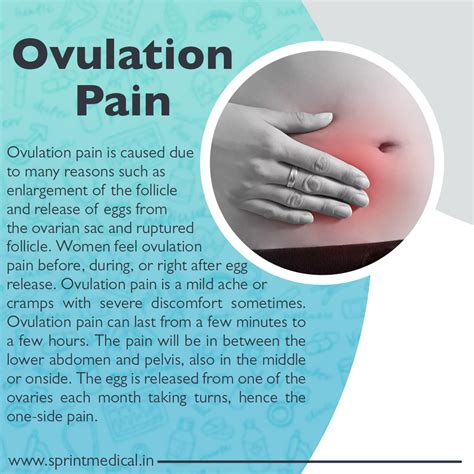
Ovulation pain symptoms can vary from woman to woman but often include a sharp or dull pain in the lower abdomen, usually on one side. The pain can be constant or intermittent and may be accompanied by other symptoms such as light bleeding or spotting, nausea, and mild pelvic discomfort. Understanding these symptoms is crucial for identifying ovulation pain and distinguishing it from other potential causes of abdominal pain.
Types of Ovulation Pain
Ovulation pain can be categorized into different types based on its characteristics and duration. Acute ovulation pain is sharp and sudden, often lasting only a few minutes. Chronic ovulation pain, on the other hand, can persist for several hours or even days. Some women may experience a dull ache that lasts for a longer period, which can be associated with other symptoms like bloating and mood changes.Causes and Mechanisms of Ovulation Pain
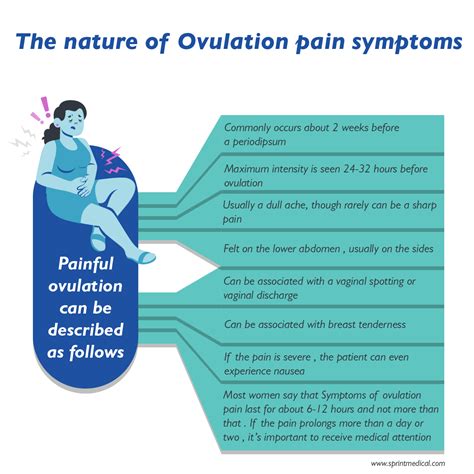
The exact causes of ovulation pain are not fully understood but are believed to involve several mechanisms. The release of the egg from the ovary is thought to cause a slight rupture, leading to bleeding and the release of prostaglandins. These substances can stimulate the smooth muscle in the fallopian tube, causing contractions that may lead to pain. Additionally, the movement of the egg through the fallopian tube can cause irritation and discomfort.
Factors Influencing Ovulation Pain
Several factors can influence the intensity and location of ovulation pain. These include the size of the ovarian follicle, the amount of prostaglandins released, and individual differences in pain perception. Women with a history of pelvic surgery, endometriosis, or other gynecological conditions may experience more severe ovulation pain due to the presence of adhesions or scar tissue.Diagnosing Ovulation Pain
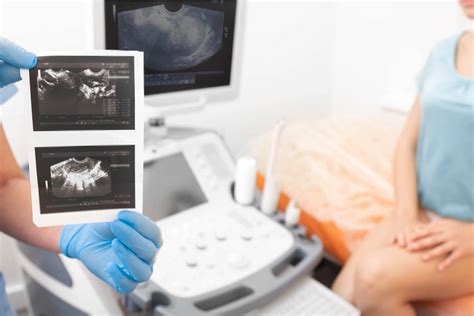
Diagnosing ovulation pain typically involves a combination of medical history, physical examination, and sometimes imaging tests. A healthcare provider may perform a pelvic exam to check for any abnormalities and ask questions about the timing and characteristics of the pain. In some cases, an ultrasound may be used to confirm ovulation and rule out other potential causes of pain.
Differential Diagnosis
It's essential to differentiate ovulation pain from other conditions that can cause abdominal pain, such as appendicitis, ectopic pregnancy, or ovarian cysts. A thorough medical evaluation can help determine the underlying cause of the pain and guide appropriate treatment.Managing Ovulation Pain
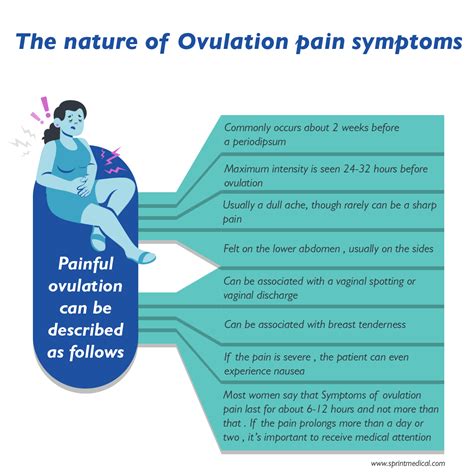
Managing ovulation pain often involves a combination of lifestyle modifications and over-the-counter pain relievers. Applying heat to the lower abdomen, engaging in gentle exercise, and practicing relaxation techniques can help alleviate discomfort. In some cases, hormonal contraceptives may be prescribed to reduce the frequency and severity of ovulation pain.
Lifestyle Modifications
Making certain lifestyle changes can help manage ovulation pain. These include maintaining a healthy diet, staying hydrated, and avoiding strenuous activities during the ovulation period. Additionally, stress-reducing techniques like meditation, yoga, or deep breathing exercises can help minimize discomfort.Ovulation Pain and Fertility
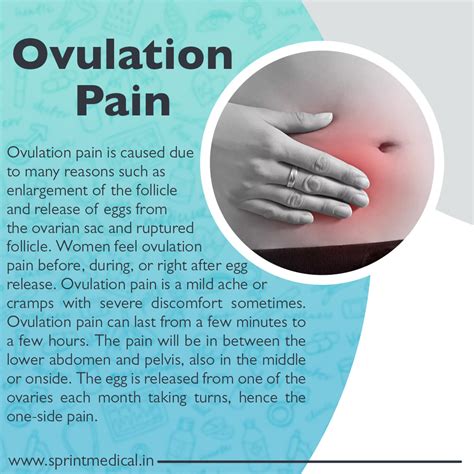
Ovulation pain can be an indicator of fertility, as it often occurs when the body is preparing for a potential pregnancy. Understanding the relationship between ovulation pain and fertility can help women who are trying to conceive. By tracking ovulation pain, women can gain insights into their menstrual cycle and timing of ovulation, which can increase the chances of conception.
Tracking Ovulation
Tracking ovulation involves monitoring the menstrual cycle, basal body temperature, and cervical mucus to predict when ovulation is likely to occur. This information can be used to time intercourse and increase the likelihood of pregnancy. Additionally, ovulation predictor kits can provide more accurate predictions of ovulation.Conclusion and Next Steps

In conclusion, understanding ovulation pain location and its characteristics can provide valuable insights into the female reproductive system. By recognizing the symptoms, causes, and mechanisms of ovulation pain, women can better manage their discomfort and use this knowledge to their advantage when trying to conceive. If you are experiencing persistent or severe ovulation pain, it's essential to consult with a healthcare provider to rule out any underlying conditions and receive appropriate guidance.
We invite you to share your experiences and questions about ovulation pain in the comments section below. Your input can help others who may be going through similar situations, and together, we can create a supportive community that fosters understanding and empowerment.
What is ovulation pain, and how common is it?
+Ovulation pain, also known as mittelschmerz, is a sensation of pain that some women experience during ovulation. It is relatively common, affecting approximately 40% of women at some point in their lives.
What are the symptoms of ovulation pain?
+The symptoms of ovulation pain can include a sharp or dull pain in the lower abdomen, usually on one side, light bleeding or spotting, nausea, and mild pelvic discomfort.
How can I manage ovulation pain?
+Ovulation pain can be managed through a combination of lifestyle modifications and over-the-counter pain relievers. Applying heat to the lower abdomen, engaging in gentle exercise, and practicing relaxation techniques can also help alleviate discomfort.
